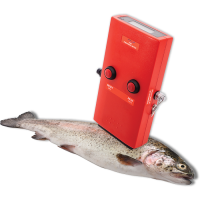 Add My Company
Add My Company
Sign In

Distell Fish Freshness Meter Freshness of fish and its measurementFish is a highly perishable commodity. When newly caught it has pleasant, sweet flavours that are highly acceptable. On storage these flavours are progressively lost and though the fish is acceptable, it is not of such high quality. Further storage produces off flavours, and ultimately these become so strong that the fish is unfit to eat. Fish is generally stored and transported in ice, and, under these conditions species from artic or temperate waters will reach the unfit state within about two weeks. Tropical fish can be held somewhat longer. Spoilage is much faster if the fish is not held at chill temperatures. It is therefore important for anyone concerned with quality of fish to be able to measure its freshness i.e. the amount of deterioration that has occurred since it was caught. Traditionally, freshness has been assessed by sensory methods i.e. using the human senses of sight, smell and touch. This approach gives an immediate appraisal of quality and can be done without damage to the fish. However, there are some difficulties. Trained and experienced persons are required, and this training takes a long time. It is not easy to make sensory assessment quantitative. The changes occurring during spoilage can be described and codified, but individuals may interpret these descriptions somewhat differently. Though a single judge may be consistent within himself, different judges will vary among themselves. This makes it difficult to establish standards that can be applied in different locations, and by different assessors. There is therefore a need for objective methods for measuring freshness that do not depend on the subjective opinion of human judges. Several chemical procedures are in use for this purpose, but all suffer from common disadvantages in respect to quality control within the industrial environment, in that they are somewhat slow to carry out, whereas quality controllers and inspectors usually require an immediate answer. The analysis requires laboratory facilities and appropriately qualified staff, a feature which renders the methods unsuitable for ‘field work’, and, expensive for factory use. The methods are destructive, and the damaged fish samples are no longer fit for processing. Generally, a quality controller or inspector needs to evaluate the freshness of a batch of fish rather than one individual sample. An appropriate number of fish are taken, the fish evaluated separately and the average of the batch calculated. The recording and calculation required, though simple, are inconvenient to carry out at the market or in the factory. There is therefore, a requirement for a rapid and objective method for measuring fish freshness in a wide range of conditions. The method should be capable of being carried out by untrained persons and should be non-destructive in use. Preferably it should also be capable of grading batches, with the minimum of computation and record keeping. The Torry Fish Freshness Meter (“Torrymeter”), has been developed to meet these requirements.
For more information on Torry Fish Freshness Meter talk to Distell.com
Enquire Now
List your company on FindTheNeedle.

